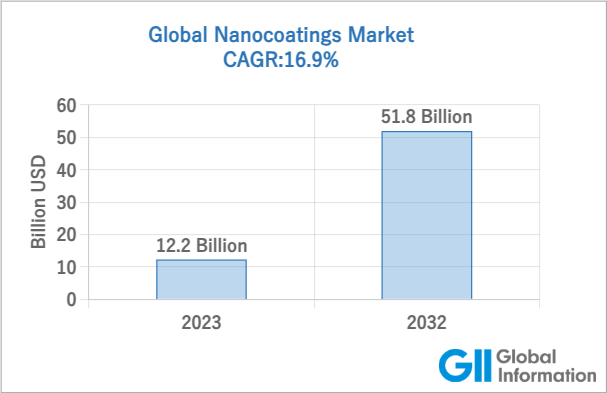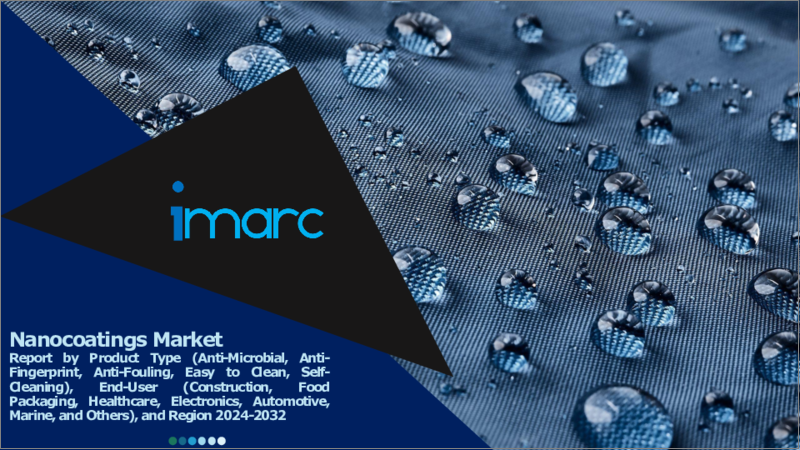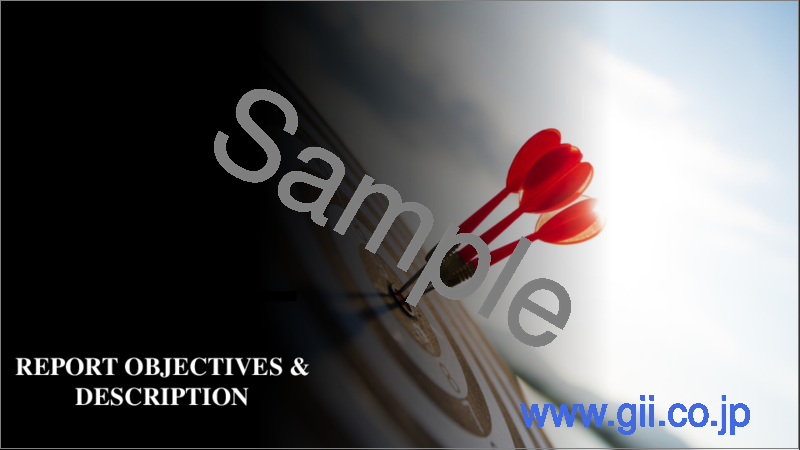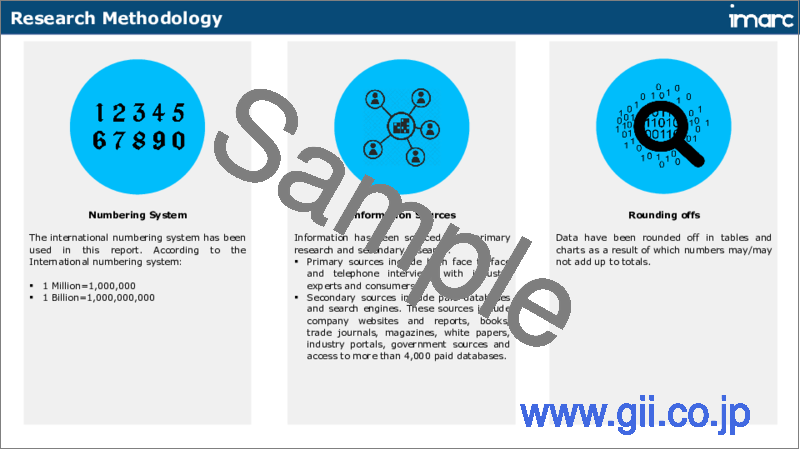|
|
市場調査レポート
商品コード
1468390
ナノコーティング市場レポート:製品タイプ、エンドユーザー、地域別、2024~2032年Nanocoatings Market Report by Product Type (Anti-Microbial, Anti-Fingerprint, Anti-Fouling, Easy to Clean, Self-Cleaning), End-User (Construction, Food Packaging, Healthcare, Electronics, Automotive, Marine, and Others), and Region 2024-2032 |
||||||
カスタマイズ可能
|
|||||||
| ナノコーティング市場レポート:製品タイプ、エンドユーザー、地域別、2024~2032年 |
|
出版日: 2024年04月08日
発行: IMARC
ページ情報: 英文 136 Pages
納期: 2~3営業日
|
- 全表示
- 概要
- 図表
- 目次
世界のナノコーティング市場規模は2023年に122億米ドルに達しました。今後、IMARC Groupは、市場は2032年までに518億米ドルに達し、2024~2032年の間に16.9%の成長率(CAGR)を示すと予測しています。

ナノコーティングとは、基材表面に特定の化学的・物理的特性を付与するために使用される、非常に微細で薄い高分子化学物質の層を指します。これには、耐食性、耐摩耗性、硬度、潤滑性、透明性、延性などが含まれます。ナノコーティングは主に、数ミクロンという実質的に小さなスケールの保護膜を加えることによって、表面の疎水性と/または疎油性特性を変化させるために使用されます。ナノコーティングは、表面のあらゆる特徴に均一に適合する層を生成するために、原子を制御された方法で堆積させる、原子ビルディングブロックを含むプロセスを通じて、極めて正確に製造することができます。ナノコーティングの世界需要は、その優れた物理的・化学的特性により、建設、食品、医療、自動車、エレクトロニクスなどの産業で力強く成長しています。
ナノコーティングの世界市場の促進要因:
その結果、航空機、セラミックタイル、ガラス窓、自動車など、温度変化や厳しい気候条件の影響を受ける製品に人気があります。
ナノコーティングは、肉眼では確認できない無色透明の保護膜を記載しています。これにより、製品の美的外観が維持され、製品の自然な光沢と透明性が保たれます。さらに、ナノコーティングされた製品は汚れが蓄積しにくいのですが、ごくまれにホコリなどの異物が表面に付着した場合でも、簡単に洗浄することができます。
ナノコーティングは、紫外線(UV)に対する保護と耐摩耗性を提供することができます。このため、製品の寿命が大幅に延び、塗装面を保護する自動車産業に最適です。
また、ナノコーティングは耐食性も備えており、塗布する金属の耐久性と寿命を向上させます。例えば、航空機部品は腐食に非常に弱いため、ナノコーティングは一般的に適用されています。
ナノコーティングは従来のコーティングに比べ、付着しにくく衛生的です。細菌や微生物の繁殖を防ぐことができます。ナノコーティングを施した自動車は、輝きを保つためにワックスをかける必要がないです。さらに、環境に優しく、毒性がなく、通気性があるため、湿気やカビを抑制し、さまざまな製品に効率的に使用することができます。
本レポートで扱う主要質問
- ナノコーティングの世界市場はこれまでどのように推移してきたか。
- ナノコーティングの世界市場における主要地域は?
- ナノコーティングの世界市場におけるCOVID-19の影響は?
- ナノコーティングの世界市場における主要製品タイプは?
- ナノコーティングの世界市場における主要エンドユーザーセグメントは?
- 世界のナノコーティング産業のバリューチェーンにおける様々な段階とは?
- 世界のナノコーティング産業における主要な促進要因と課題は何か?
- 世界のナノコーティング産業の構造と主要参入企業は?
- 世界のナノコーティング産業における競合の程度は?
目次
第1章 序文
第2章 調査範囲と調査手法
- 調査目的
- 利害関係者
- データソース
- 一次情報
- 二次情報
- 市場推定
- ボトムアップアプローチ
- トップダウンアプローチ
- 調査手法
第3章 エグゼクティブサマリー
第4章 イントロダクション
- 概要
- 主要産業動向
第5章 ナノコーティングの世界市場
- 市場概要
- 市場実績
- COVID-19の影響
- 市場内訳:製品タイプ別
- 市場内訳:エンドユーザー別
- 市場内訳:地域別
- 市場予測
- SWOT分析
- 概要
- 強み
- 弱み
- 機会
- 脅威
- バリューチェーン分析
- ポーターのファイブフォース分析
- 概要
- 買い手の交渉力
- 供給企業の交渉力
- 競合の程度
- 新規参入業者の脅威
- 代替品の脅威
- 価格分析
- 主要価格指標
- 価格構造
第6章 市場内訳:製品タイプ別
- 抗菌剤
- 抗指紋
- 防汚
- 簡易クリーニング
- セルフクリーニング
第7章 市場内訳:エンドユーザー別
- 建設
- 食品包装
- 医療
- エレクトロニクス
- 自動車
- 海洋
- その他
第8章 市場内訳:地域別
- 北米
- 欧州
- アジア太平洋
- 中東・アフリカ地域
- ラテンアメリカ
第9章 製造工程
- 製品概要
- 原材料の要件
- 製造プロセス
- 主要成功要因とリスク要因
第10章 競合情勢
- 市場構造
- 主要企業
- 主要企業のプロファイル
- BASF
- Bio-Gate
- Buhler
- Nanogate
- PPG Industries
- AdMat Innovations
- Cima NanoTech
- CG2 NanoCoatings
- Cleancorp
- Ecological Coatings
- Eikos
- Inframat
- Integran Technologies
- Nanofilm
- Nanomech
- Nanovere Technologies
- Nanophase Technologies
- P2i
- Surfix
- Tesla NanoCoatings
List of Figures
- Figure 1: Global: Nanocoatings Market: Major Drivers and Challenges
- Figure 2: Global: Nanocoatings Market: Sales Value (in Billion US$), 2018-2023
- Figure 3: Global: Nanocoatings Market: Breakup by Product Type (in %), 2023
- Figure 4: Global: Nanocoatings Market: Breakup by End-User (in %), 2023
- Figure 5: Global: Nanocoatings Market: Breakup by Region (in %), 2023
- Figure 6: Global: Nanocoatings Market Forecast: Sales Value (in Billion US$), 2024-2032
- Figure 7: Nanocoatings Market: Price Structure
- Figure 8: Global: Nanocoatings Industry: SWOT Analysis
- Figure 9: Global: Nanocoatings Industry: Value Chain Analysis
- Figure 10: Global: Nanocoatings Industry: Porter's Five Forces Analysis
- Figure 11: Global: Nanocoatings (Anti-Microbial) Market: Sales Value (in Million US$), 2018 & 2023
- Figure 12: Global: Nanocoatings (Anti-Microbial) Market Forecast: Sales Value (in Million US$), 2024-2032
- Figure 13: Global: Nanocoatings (Anti-Fingerprint) Market: Sales Value (in Million US$), 2018 & 2023
- Figure 14: Global: Nanocoatings (Anti-Fingerprint) Market Forecast: Sales Value (in Million US$), 2024-2032
- Figure 15: Global: Nanocoatings (Anti-Fouling) Market: Sales Value (in Million US$), 2018 & 2023
- Figure 16: Global: Nanocoatings (Anti-Fouling) Market Forecast: Sales Value (in Million US$), 2024-2032
- Figure 17: Global: Nanocoatings (Easy to Clean) Market: Sales Value (in Million US$), 2018 & 2023
- Figure 18: Global: Nanocoatings (Easy to Clean) Market Forecast: Sales Value (in Million US$), 2024-2032
- Figure 19: Global: Nanocoatings (Self-Cleaning) Market: Sales Value (in Million US$), 2018 & 2023
- Figure 20: Global: Nanocoatings (Self-Cleaning) Market Forecast: Sales Value (in Million US$), 2024-2032
- Figure 21: Global: Nanocoatings (Construction) Market: Sales Value (in Million US$), 2018 & 2023
- Figure 22: Global: Nanocoatings (Construction) Market Forecast: Sales Value (in Million US$), 2024-2032
- Figure 23: Global: Nanocoatings (Food Packaging) Market: Sales Value (in Million US$), 2018 & 2023
- Figure 24: Global: Nanocoatings (Food Packaging) Market Forecast: Sales Value (in Million US$), 2024-2032
- Figure 25: Global: Nanocoatings (Healthcare) Market: Sales Value (in Million US$), 2018 & 2023
- Figure 26: Global: Nanocoatings (Healthcare) Market Forecast: Sales Value (in Million US$), 2024-2032
- Figure 27: Global: Nanocoatings (Electronics) Market: Sales Value (in Million US$), 2018 & 2023
- Figure 28: Global: Nanocoatings (Electronics) Market Forecast: Sales Value (in Million US$), 2024-2032
- Figure 29: Global: Nanocoatings (Automotive) Market: Sales Value (in Million US$), 2018 & 2023
- Figure 30: Global: Nanocoatings (Automotive) Market Forecast: Sales Value (in Million US$), 2024-2032
- Figure 31: Global: Nanocoatings (Marine) Market: Sales Value (in Million US$), 2018 & 2023
- Figure 32: Global: Nanocoatings (Marine) Market Forecast: Sales Value (in Million US$), 2024-2032
- Figure 33: Global: Nanocoatings (Other End-Users) Market: Sales Value (in Million US$), 2018 & 2023
- Figure 34: Global: Nanocoatings (Other End-Users) Market Forecast: Sales Value (in Million US$), 2024-2032
- Figure 35: North America: Nanocoatings Market: Sales Value (in Million US$), 2018 & 2023
- Figure 36: North America: Nanocoatings Market Forecast: Sales Value (in Million US$), 2024-2032
- Figure 37: Europe: Nanocoatings Market: Sales Value (in Million US$), 2018 & 2023
- Figure 38: Europe: Nanocoatings Market Forecast: Sales Value (in Million US$), 2024-2032
- Figure 39: Asia Pacific: Nanocoatings Market: Sales Value (in Million US$), 2018 & 2023
- Figure 40: Asia Pacific: Nanocoatings Market Forecast: Sales Value (in Million US$), 2024-2032
- Figure 41: Middle East and Africa: Nanocoatings Market: Sales Value (in Million US$), 2018 & 2023
- Figure 42: Middle East and Africa: Nanocoatings Market Forecast: Sales Value (in Million US$), 2024-2032
- Figure 43: Latin America: Nanocoatings Market: Sales Value (in Million US$), 2018 & 2023
- Figure 44: Latin America: Nanocoatings Market Forecast: Sales Value (in Million US$), 2024-2032
- Figure 45: Nanocoatings Manufacturing: Detailed Process Flow
List of Tables
- Table 1: Global: Nanocoatings Market: Key Industry Highlights, 2023 and 2032
- Table 2: Global: Nanocoatings Market Forecast: Breakup by Product Type (in Million US$), 2024-2032
- Table 3: Global: Nanocoatings Market Forecast: Breakup by End-User (in Million US$), 2024-2032
- Table 4: Global: Nanocoatings Market Forecast: Breakup by Region (in Million US$), 2024-2032
- Table 5: Nanocoatings Manufacturing: Raw Material Requirements
- Table 6: Global: Nanocoatings Market: Competitive Structure
- Table 7: Global: Nanocoatings Market: Key Players
The global nanocoatings market size reached US$ 12.2 Billion in 2023. Looking forward, IMARC Group expects the market to reach US$ 51.8 Billion by 2032, exhibiting a growth rate (CAGR) of 16.9% during 2024-2032.
Nanocoating refers to very fine, thin layers of polymeric chemical substances that are used to impart specific chemical and physical characteristics to a substrate surface. This includes corrosion resistance, abrasion resistance, hardness, lubricity, transparency, and ductility. Nanocoatings are predominantly used to alter the hydrophobic and/or oleophobic properties of a surface by adding a protective coating on a substantially small scale of several microns. A nanocoating can be produced with utmost precision through a process which involves atomic building blocks, where atoms are deposited in a controlled fashion to produce a layer that conforms uniformly on every distinct feature of the surface. Catalysed by their superior physical and chemical properties the global demand of nano coatings is currently growing robustly in industries such as construction, food, healthcare, automotive, electronics, etc.
Global Nanocoatings Market Drivers:
Nanocoatings provide resistance to fluctuations in temperature, as a result, they are popular in products that are impacted by temperature changes and harsh climatic conditions such as aircrafts, ceramic tiles, glass windows, automobiles, etc.
Nanocoatings provide a clear, colourless protection that cannot be detected by the naked eye. This maintains a products aesthetic appearance and preserves the natural gloss and transparency of the product. Moreover, nano coated products do not easily accumulate dirt, however, on few occasions when foreign elements such as dust adhere to the surface, they can be easily cleaned.
Nanocoatings are able to provide protection against Ultra Violet (UV) light and resistance against abrasion. This significantly increases the life span of products and makes them ideal for the automotive industry to protect paint surfaces.
Nanocoatings also provide corrosion resistance, this increases the durability and lifespan of the metals where they are applied. For example, nano coatings are commonly applied on air craft parts as they are highly susceptible to corrosion.
Nanocoatings are anti-adhesive and more hygienic as compared to conventional coatings. They prevent the growth of bacteria and microorganisms. Automobiles with nano coatings do not require waxing to maintain their shine. Moreover, they are also environment friendly, non- toxic and breathable, enabling them to be efficiently used on a variety of products as they inhibit damp and mold.
Key Market Segmentation:
IMARC Group provides an analysis of the key trends in each sub-segment of the global nanocoatings market report, along with forecasts at the global and regional level from 2024-2032. Our report has categorized the market based on product type and end-user.
Breakup by Product Type:
Anti-Microbial
Anti-Fingerprint
Anti-Fouling
Easy to Clean
Self-Cleaning
Based on the product type, the market has been segmented into anti-microbial, anti-fingerprint, anti-fouling, easy to clean and self-cleaning.
Breakup by End-User:
Construction
Food Packaging
Healthcare
Electronics
Automotive
Marine
Others
On the basis of end-user, the market has been segmented into construction, food packaging, healthcare, electronics, automotive, marine and others.
Breakup by Region:
North America
Europe
Asia Pacific
Middle East and Africa
Latin America
Region-wise, the market has been segmented into North America, Europe, Asia Pacific, Middle East and Africa, and Latin America.
Competitive Landscape:
The competitive landscape of the market has also been examined with some of the key players being BASF, Bio-Gate, Buhler, Nanogate, PPG Industries, AdMat Innovations, Cima NanoTech, CG2 NanoCoatings, Cleancorp, Ecological Coatings, Eikos, Inframat, Integran Technologies, Nanofilm, Nanomech, Nanovere Technologies, Nanophase Technologies, P2i, Surfix and Tesla NanoCoatings.
This report provides a deep insight into the global nanocoatings market covering all its essential aspects. This ranges from macro overview of the market to micro details of the industry performance, recent trends, key market drivers and challenges, SWOT analysis, Porter's five forces analysis, value chain analysis, etc. This report is a must-read for entrepreneurs, investors, researchers, consultants, business strategists, and all those who have any kind of stake or are planning to foray into the nanocoatings industry in any manner.
Key Questions Answered in This Report:
- How has the global nanocoatings market performed so far and how will it perform in the coming years?
- What are the key regions in the global nanocoatings market?
- What has been the impact of COVID-19 on the global nanocoatings market?
- What are the major product types in the global nanocoatings market?
- What are the key end-user segments in the global nanocoatings market?
- What are the various stages in the value chain of the global nanocoatings industry?
- What are the key driving factors and challenges in the global nanocoatings industry?
- What is the structure of the global nanocoatings industry and who are the key players?
- What is the degree of competition in the global nanocoatings industry?
Table of Contents
1 Preface
2 Scope and Methodology
- 2.1 Objectives of the Study
- 2.2 Stakeholders
- 2.3 Data Sources
- 2.3.1 Primary Sources
- 2.3.2 Secondary Sources
- 2.4 Market Estimation
- 2.4.1 Bottom-Up Approach
- 2.4.2 Top-Down Approach
- 2.5 Forecasting Methodology
3 Executive Summary
4 Introduction
- 4.1 Overview
- 4.2 Key Industry Trends
5 Global Nanocoatings Market
- 5.1 Market Overview
- 5.2 Market Performance
- 5.3 Impact of COVID-19
- 5.4 Market Breakup by Product Type
- 5.5 Market Breakup by End-User
- 5.6 Market Breakup by Region
- 5.7 Market Forecast
- 5.8 SWOT Analysis
- 5.8.1 Overview
- 5.8.2 Strengths
- 5.8.3 Weaknesses
- 5.8.4 Opportunities
- 5.8.5 Threats
- 5.9 Value Chain Analysis
- 5.10 Porters Five Forces Analysis
- 5.10.1 Overview
- 5.10.2 Bargaining Power of Buyers
- 5.10.3 Bargaining Power of Suppliers
- 5.10.4 Degree of Competition
- 5.10.5 Threat of New Entrants
- 5.10.6 Threat of Substitutes
- 5.11 Price Analysis
- 5.11.1 Key Price Indicators
- 5.11.2 Price Structure
6 Market Breakup by Product Type
- 6.1 Anti-Microbial
- 6.1.1 Market Trends
- 6.1.2 Market Forecast
- 6.2 Anti-Fingerprint
- 6.2.1 Market Trends
- 6.2.2 Market Forecast
- 6.3 Anti-Fouling
- 6.3.1 Market Trends
- 6.3.2 Market Forecast
- 6.4 Easy to Clean
- 6.4.1 Market Trends
- 6.4.2 Market Forecast
- 6.5 Self-Cleaning
- 6.5.1 Market Trends
- 6.5.2 Market Forecast
7 Market Breakup by End-User
- 7.1 Construction
- 7.1.1 Market Trends
- 7.1.2 Market Forecast
- 7.2 Food Packaging
- 7.2.1 Market Trends
- 7.2.2 Market Forecast
- 7.3 Healthcare
- 7.3.1 Market Trends
- 7.3.2 Market Forecast
- 7.4 Electronics
- 7.4.1 Market Trends
- 7.4.2 Market Forecast
- 7.5 Automotive
- 7.5.1 Market Trends
- 7.5.2 Market Forecast
- 7.6 Marine
- 7.6.1 Market Trends
- 7.6.2 Market Forecast
- 7.7 Others
- 7.7.1 Market Trends
- 7.7.2 Market Forecast
8 Market Breakup by Region
- 8.1 North America
- 8.1.1 Market Trends
- 8.1.2 Market Forecast
- 8.2 Europe
- 8.2.1 Market Trends
- 8.2.2 Market Forecast
- 8.3 Asia Pacific
- 8.3.1 Market Trends
- 8.3.2 Market Forecast
- 8.4 Middle East and Africa
- 8.4.1 Market Trends
- 8.4.2 Market Forecast
- 8.5 Latin America
- 8.5.1 Market Trends
- 8.5.2 Market Forecast
9 Manufacturing Process
- 9.1 Product Overview
- 9.2 Raw Material Requirements
- 9.3 Manufacturing Process
- 9.4 Key Success and Risk Factors
10 Competitive Landscape
- 10.1 Market Structure
- 10.2 Key Players
- 10.3 Profiles of Key Players
- 10.3.1 BASF
- 10.3.2 Bio-Gate
- 10.3.3 Buhler
- 10.3.4 Nanogate
- 10.3.5 PPG Industries
- 10.3.6 AdMat Innovations
- 10.3.7 Cima NanoTech
- 10.3.8 CG2 NanoCoatings
- 10.3.9 Cleancorp
- 10.3.10 Ecological Coatings
- 10.3.11 Eikos
- 10.3.12 Inframat
- 10.3.13 Integran Technologies
- 10.3.14 Nanofilm
- 10.3.15 Nanomech
- 10.3.16 Nanovere Technologies
- 10.3.17 Nanophase Technologies
- 10.3.18 P2i
- 10.3.19 Surfix
- 10.3.20 Tesla NanoCoatings






